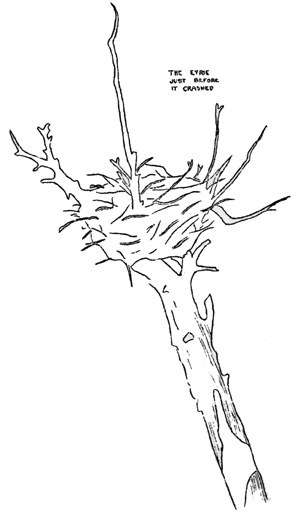

|
|
NATURE NOTES FROM ACADIA
The last number of "Nature Notes from Acadia" (June, 1933) contained an account of an ill-fated nest of the Bald Eagles. On the day I first saw the eyrie I took a single snapshot of it, having no premonitions of the tragedy which came on the wings of the night wind. The nest, one of many years' standing, was doomed to an early destruction, however, since the big yellow birch in which it was cradled had been dead for many years. 
Since the eyrie was in a secluded part of a heavily wooded area, my companion and I were, undoubtedly, the last to see, let alone photograph, the big nest. That night it went down before a fierce gale and carried its two helpless feathered occupants with it. Fortunately, the photograph proved to be a good one, and from it I have made the rough sketch which appears on the right. The account of the discovery of the eaglets nine days after the crash, appeared in the June number of "Nature Notes from Acadia." At present the lone survivor of this tragedy is in perfect health, but his badly injured wing has not recovered sufficiently to permit flight. Once a day the big bird is fed a quantity of raw meat or freshly-caught fish, sometimes both. If no other person is with me I enter his spacious cage and usually experience no trouble feeding him from the hand and stroking the feathers on his head and neck. After a period of molt in early July when his cage was littered with down, the eaglet became well feathered out. Now the plumage is very dark, almost black in color. The so-called "Black Eagles" which are occasionally seen along the Maine seacoast are undoubtedly these young of the Bald Eagle. - Temporary Park Naturalist |
| <<< Previous | > Cover < |
nature_notes/acad/vol2-3h.htm
09-Jan-2006